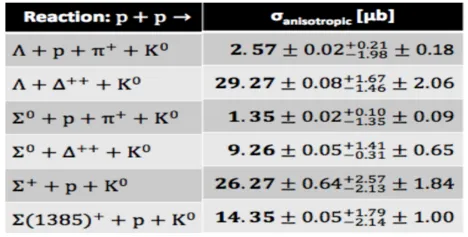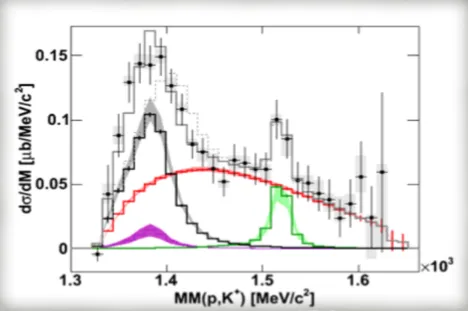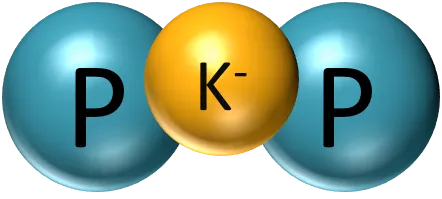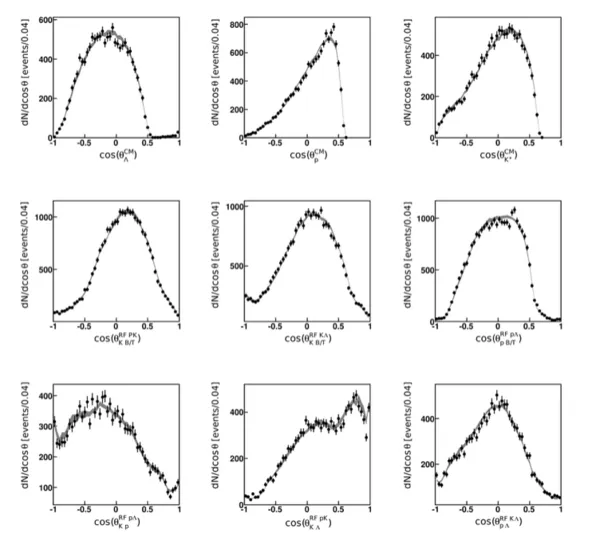Resonance production and strangeness at intermediate energies
Particle production in hadron-hadron collisions at energies of few GeV are driven by the intermediate excitation of rather broad resonances.
In order to investigate the dynamic of such reactions the measurement of these resonances is rather important but data are rather scarce, since the detection of short-lived particles (cτ ~ few femtometers) can be very challenging.
For this purpose we use measured proton+proton collisions at a beam energy of 3.5 GeV, which were taken with the HADES experiment at GSI. This experiment has excellent capabilities for hadron identification and a sufficient acceptance to allow an exclusive analysis with several particles in the final state.
We focused on final states containing strange hadrons and we have developed and carried out several analysis methods to measure the cross section and the line shape of baryonic resonances in proton-proton reactions for different final states.

Three different categories of investigations have been defined:
1. Exclusive measurement of :
• Resonances accompanying strangeness production
• Strange Resonances
• Molecular States
The table shows the extracted cross-sections of some final states containing strangeness for the fixed target reaction p+p at 3.5 GeV measured by HADES . Our innovative contribution consisted of being able to distinguish the cases where the Δ++ was produced and then decayed to p+π+ with respect to the free p+π+ production. This looks boring at first sight but allows to pin down in a quantitative way the role played by resonances in particle production at these energies.

2. Coherent strangeness production:
A prominent example of baryonic resonances that we have investigated is the Λ(1405).
This resonance is of great theoretical interest since it appears to be not a usual 3-quark state but a meson-baryon quasi bound state. In particular, chiral effective field theory predicts the Λ(1405) to emerge naturally from the interference of two p and an Σπ poles. This motivated us to measure the line shape of this hyperon, from which one can extract important information about the dynamics between antikaons and nucleons below threshold.
The Figure on the side shows the spectral shape of the Λ(1405) obtained in p+p reaction at 3.5 GeV as measured by HADES. The Λ(1405) line shape is found to be shifted about 20 MeV below the expected pole mass of 1405 MeV. This shift is attributed to the fact that the dynamic production of the Λ(1405) involved more intermediate channels, being this resonance a molecular state and not a normal hadron and this fact is visible from the shift of the spectral shape. Other reactions, as photon-induced reactions, show indeed a completely different position of the pole mass.

3. Kaonic bound states:
Kaonic bound states are molecular states where an antikaon binds two or more nucleons together in a bound state.
These states were predicted around 2002 and the measurement of their binding energy and width would deliver very precise and unique information about the N interaction in vacuum.
We attempt to look for the existence of the theoretical state ppK- which is predicted to be produced also in p+p reactions (p+p at 3.1, 3.5 geV). In this reaction a ppK, the lightest of all the kaonic bound states, should be produced together with a K+.
Since the ppK- state is predicted to be quite broad, an exclusive measurement of the whole reaction is necessary in order to reduce possible background sources.

Such an exclusive event reconstruction containing four particles needs a large acceptance spectrometer.
We have carried two p+p runs at the SIS18 at GSI with the FOPI and HADES spectrometers to search for the ppK- in the reaction p+p→ppK- + K+→Λ + p + K+. For a better Λ reconstruction and triggering in the FOPI experiment we have build a specialized detector called SILVIO (Silicon for Λ Vertexing and Identification Online) shown on the right side.
It is a detector consisting of two layers of silicon detectors, which are arranged in such way, that around 60% of the produced Λ particles decay between these two layers. If this happens one obtains a characteristic hit multiplicity difference on the two layers (first layer=Lambda hit, second layer=p+pi- hit), which can be used for triggering. A reduction factor of around 14 for the minimum bias events was achieved with this device.
By analyzing the data we found out that it is possible for example, that the three particles are produced directly, via an N* resonance or via the decay of a ppK- cluster.

Furthermore, we have asked ourselves if broad N* resonances (Width~ 150-200 MeV) with masses between 1600 and 1900 MeV can interfere, because of the overlap of the mass distributions, on their way to the decay N*→KΛ.
Eventually, interference effects might result in deviations of angular and invariant mass distributions with respect to the phase-space distribution and hence be mistaken for exotic signals.
By analysing the exclusive p+p→p+K++Λ reaction with the partial wave analysis tool, all interferences can be taken into account and the N* amplitudes and relative shifts between the different waves can be determined.
This analysis was first carried out for the HADES data p+p→p+K++Λ ( at 3.5 GeV) where we demonstrate that the data can be described without the contribution of any ppK- cluster decaying into a Λ-p pair but considering only the contribution of different N* states.
The Figure below shows the angular distributions in different reference systems for the final state and the data are shown together with the PWA results.
We can see that the experimental features are caught by the PWA and this allowed us to calculate solid upper limits for the ppK- cross-sections and the latter was found to be equal to several μbarn.

Since the observation of the ppK- state in p+p reactions was claimed by the DISTO experiment and that since that analysis had completely neglected possible interference effects from N* resonances, we decided to develop a general framework to analyse more data sets for the reaction p+p→p+K++Λ at the same time.
We took the seven data sets of the reaction p+p→p+K++Λ measured by the COSY-TOF, DISTO, FOPI and HADES collaboration in fixed target experiment for beam energies between 1.9 and 4.3 GeV and analysed them by means of a common PWA framework. We could describe all data sets at the same time by employing only N* and non resonant amplitude and we extracted for the first time the excitation functions of several N* resonance. The latter are shown in the Figure below.

The next and last step of this project will be to evaluate a new upper limit for the kaonic bound state ppK- on the base of all seven data sets.
This does not exclude the formation of kaonic bound states in p+p reactions but demonstrates that their measurement is extremely challenging.